10 Hairy Legs presents work by four choreographers at New York Live Arts.
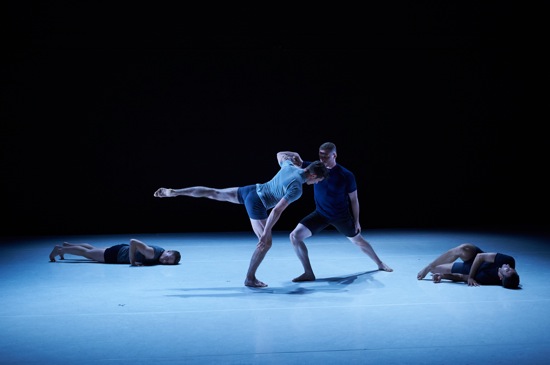
Doug Varone’s mark for 10 Hairy Legs. (L to R): Derek Crescenti, Tony Bordonaro, Alex Biegelson, and William Tomaskovic. Photo: Rachel Neville
There’s a problem. Well, not much of one. Randy James gave the name 10 Hairy Legs to the all-male company he founded in 2012 . I counted twelve legs (and won’t debate the hairiness quotient).
Obviously, I don’t recommend a name change, but I bring it up because I wish that the program I saw at New York Live Arts had included a work for all six of the engaging performers. Instead it consisted of two duets (one by David Parker, one by Tiffany Mills) and two quartets (by Doug Varone and by Megan Williams). Perhaps practical considerations (such as no long waits between dances) dictated the casting. . . .
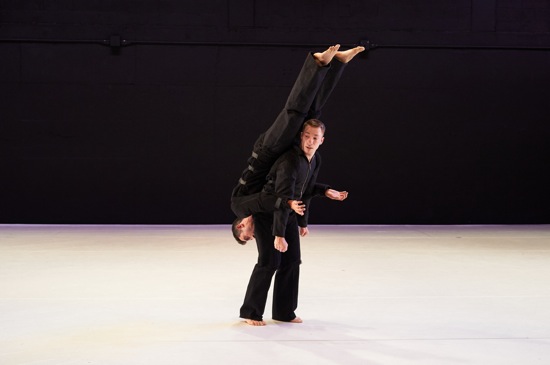
William Tomaskovic (upside down) and Derek Crescenti of 10 Hairy Legs in David Parker’s Slapstuck. Photo: Rachel Neville
Except for the opening work, Parker’s Slapstuck, all were premieres. Slapstuck has a deliciously nutty premise. It takes a while to discover that the outfits of these two rivalrous fellows (Derek Crescenti and William Tomaskovic) are loaded with Velcro. The only sound beside the men’s stamps and claps is that wrenching apart of the broad strips sewn to their costumes whenever they come together. As the boisterous soft shoe number they attempt expands, problems develop. One man, stuck to another, can be carried along like an unanticipated burden. Crescenti, flailing unwisely, becomes stuck to himself and can only get free with a might ripping noise. Among the surprises (to the men as to us): their hand grip proves to have illusory glue, and wherever one wishes to go, the other may be yanked along. Slapstuck is hilarious, but it also sends a firm little message about partnership and its liabilities.
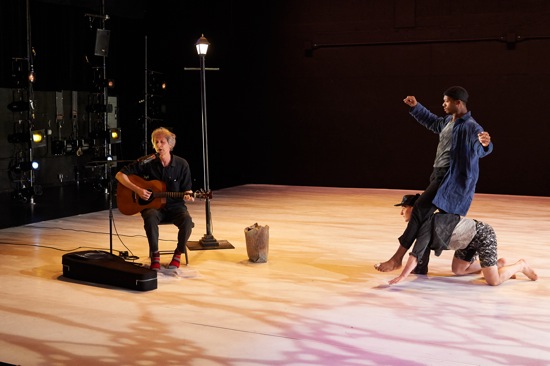
Tiffany Mills’ Should We Go? Peter Whitehead (L) and Kyle Marshall astride Robert Mark Burke. Photo: Rachel Neville
Mills’ Should We Go? turns out to have been inspired by Samuel Beckett’s play Waiting for Godot. I hadn’t read the program note noting it as a “springboard” before the piece began, but the themes of waiting and of a long-term relationship are evident from the beginning. Robert Mark Burke lounges on a park bench. Kyle Marshall stands near the chair where composer Peter Whitehead will sit to play his guitar, sing, and twiddle dials. Time hangs heavy. Burke gets playful with the shoes he has evidently removed, holding one to his ear as if it were a cell phone. Marshall tosses socks at him, and he responds by trying to put it on over his shoe, once he has figured out that it is a shoe. Had I read the program first, I might have identified this as a delaying tactic, instead of wondering if Burke’s character was meant to be childish.
I enjoy Whitehead’s guitar playing and quiet singing of his own compositions, although I wonder what this character is doing here in this place with these two guys he’s watching intently. Maybe he’s just another Central Park denizen who has gotten curious. At some point, however, you realize the lyrics are relevant; he sings of waiting for something that never comes.
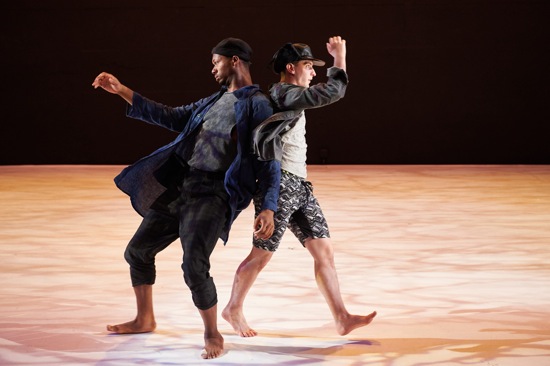
Kyle Marshall (L) and Robert Mark Burke of 10 Hairy Legs in Should We Go? Photo: Rachel Neville
Burke and Marshall depict what seems to be end-of-the-line lassitude and fiddling-around with charm and skill. These men’s relationship to each other appears to be more one of tolerance than one of love. They share the bench, but aren’t above nudging each other off. One man’s hand rests on the other’s knee, one’s head on the other’s shoulder. Burke leans over and (briefly) makes Marshall’s lap his pillow. They scour the horizon, point in different directions: which way to go? They look up: will it rain?
A diversion of sorts occurs when Burke pulls carrots out of a bag near Whitehead and starts tossing them around, as if he’s looking for something better. They’re edible, so that’s something. Marshall tries to leave but is pulled back. At one point, the two perform separate, mildly tantrummy dancing. But that’s not what you remember about this work of Mills’ (to which Burke and Marshall contributed). It’s the engaging —if sometimes a bit too whimsical—behavior of the two and the naturalness with which the performers confront their roles.
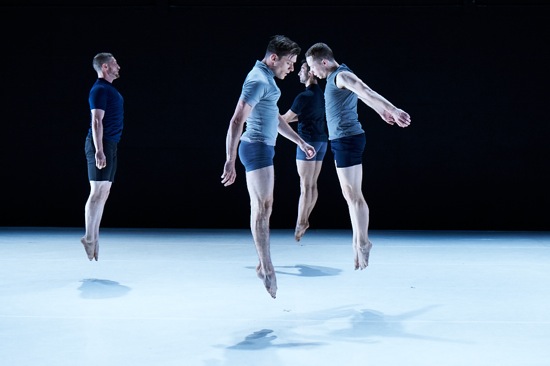
Doug Varone’s mark. (L to R): Alex Biegelson, Tony Bordonaro, William Tomaskovic, and Derek Crescenti of 10 Hairy Legs. Photo; Rachel Neville
Varone’s mark mates strongly designed movements with cool precision. Alex Biegelson, Tony Bordonaro, Crescenti, and Tomaskovic wear tight shorts and t-shirts in shades of blue and gray, and Amanda K. Ringger has lit the dark back wall of New York Live Arts until it glows blue too. Yet the initial sound (Holly Herndon’s Terminal) announces catastrophe the minute the piece begins. You imagine a bucket load of gravel being forcefully emptied, then another, then another, before a rhythm sets in.
The only thing that’s clear about the title is that Varone doesn’t want us to think that it’s somebody’s name, and definitions of the word take up too much dictionary space to focus on one. However, it is clear that these are agile men collaborating. For instance, three catch one and lift him. They’re watchful—ready to integrate themselves into a design that’s forming, to follow a leader. They send gestural signals. One moment, each is dancing his own steps; the next moment they’ve slipped into unison or two-part counterpoint.
But Herndon’s other two startling pieces of music are also dangerous sounding. Interlude’s burblings and gulpings keep being choked off, and the intermittent soprano voice of Dao contends with spattering percussion. And while the men, trot, run, prance, leap, and raise their legs like flags, they also do some edgier things, such as raising fisted hands overhead, crawling, rolling, and crouching bent over, as if they’ve been punched in the gut. Their projected shadows tangle on the wall behind them. As the lights slowly fade, our last image is of them kneeling, their heads dropped to their chests. In retrospect, I wonder whether this sometimes playful ordeal is an abstraction of sports.
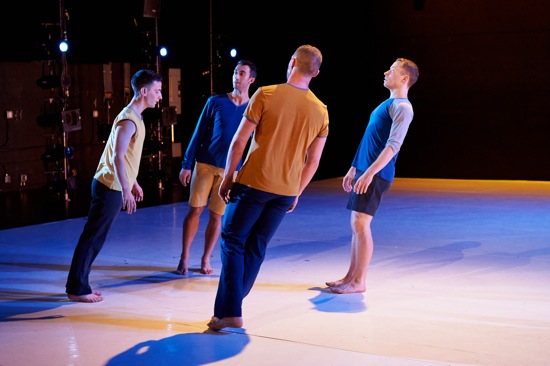
Megan Williams’ Quadrivium for 10 Hairy Legs. (L to R): Robert Mark Burke, William Tomaskovic, Alex Biegelson, and Derek Crescenti. Photo: Rachel Neville
The cast of Williams’s Quadrivium differs from Varone’s mark by one man. Burke joins Biegelson, Crescenti, and Tomaskovic. The accompaniment is Steve Reich’s New York Counterpoint, and and Jason Flamos’s lighting creates a warm place. The men’s everyday casual attire is credited to Naomi Luppescu.
These guys want us to like them and aren’t sure we will. At least, that’s how I read the initial movement, when they stand shoulder to shoulder, close to the first row, and inspect us. Occasionally one of them gives a small, uncertain smile. OK, guys we’re with you, and —as Reich’s initial sounds ring out—we can tell by the group hug that these are buddies. That they hold hands as a foursome and in pairs to spin confirms this, as do the way their tricky individual paths come together in elaborate counterpoint. They face one another and practice leaning as far to the side as they can without falling.
Williams has fitted her springy, well-designed choreography intrepidly to Reich’s insistent rhythms (a strong repeating section in ¾ time incites big, scooping-the-air steps). I suspect that she has not named her dance after the four areas of study laid out in the sixth century (arithmetic, geometry, music, and astronomy), but instead treated “quadrivium” in its more basic meaning as simply as a place where four ways meet. Which in this case they do—pleasantly, cleverly, and with good humor.
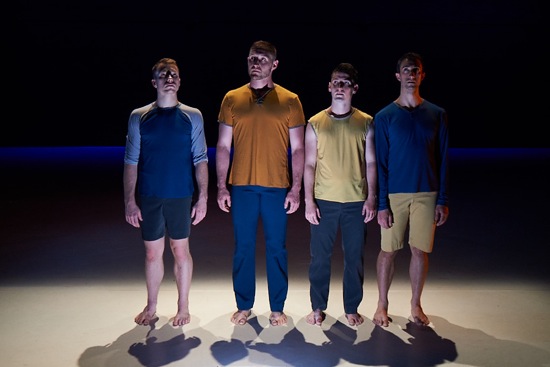
Here’s looking at us. (L to R): Derek Crescenti, Alex Biegelson, Robert Mark Burke, and William Tomaskovic in Megan Williams’ Quadrivium. Photo: Rachel Neville
Varone and Williams chose, it seems to me, a structure that has a built-in difficulty. A group of four doesn’t present many spatial options: two and two, three and one, all four. The spacing readily suggests compass points, a card game, a doubles match, two couples. Decades ago, the pioneering choreographer Doris Humphrey decreed that symmetry could be “lifeless” and should be used with discretion. I’m not saying that these two choreographers didn’t cope admirably with that difficulty or that I quibble over artistic director James’s choices. It’s just that I look forward to seeing what ten nimble hairy legs onstage together can do.

I find your remark on symmetry and Doris Humphrey’s warning to use it sparingly especially interesting for the way it focuses much of what you’ve said earlier. It’s a most useful and thought-provoking way of enlarging the conversation, which is what one hopes that criticism will always do.
Louis Horst too, warned that the inherent symmetry of the quartet posed choreographic problems. (His Group Forms course consisted of the creation of a trio, a quartet, and a quintet, believing that all group works were really variations of 3, 4, & 5’s. ) Yet, he pointed to the string quartet as the perfect model and called Limon’s Moor’s Pavane the epitome of perfection using 4 dancers. He famously explained, “a trio shouldn’t look like a quartet with one home sick!”